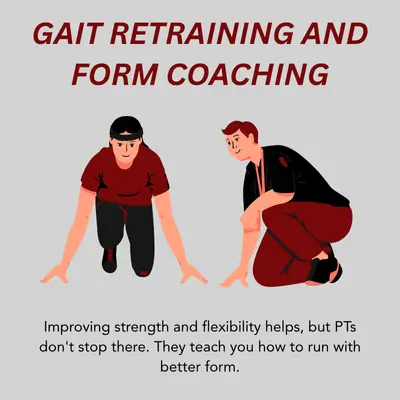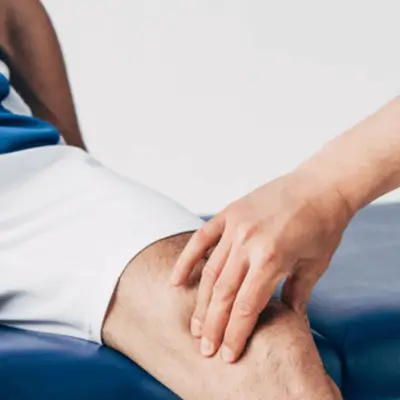Running looks simple. Put one foot in front of the other and go. But half of all runners get hurt each year. Most get overuse injuries from repeating the same motions. Understanding running mechanics can help prevent more overuse injuries. The real problem isn’t always how much you run. It’s how you run.
Bad form creates muscle imbalances. Weak spots and tight spots throw off your movement patterns and hurt core stability. This leads to joint stress and pain. But here’s the good news: physical therapy and rehabilitation can fix these issues. Sports PTs use rehabilitation exercises to improve movement. They help runners move better, run safer, and perform stronger.
Why Your Running Form Matters

Running injuries don’t just happen by chance. Poor biomechanics cause most problems. When your stride is off or your foot strike pattern is wrong, you create extra stress on joints and muscles. Do this thousands of times per run, and you’re asking for trouble.
Good form spreads impact forces evenly across your body. It saves energy and reduces wear and tear. Bad form does the opposite. Heavy heel strikes send shock waves up your legs. Overstriding creates a braking effect that strains muscles. Poor cadence means harder impacts with each step.
Fix your form and you’ll see two big wins. First, fewer injuries. Second, performance enhancement. Better running mechanics mean you use less energy at the same pace. You’ll run faster or farther with the same effort. That’s the power of running efficiency.
How PTs Analyze Your Running
Sports physical therapists use high-tech tools to study how you run. A gait analysis starts with a full exam of your strength, flexibility, and mobility. The PT checks your injury history and looks for muscle imbalances that might affect your form.
Next comes the video work. Slow motion video analysis captures your running form from different angles. The PT can spot problems your eyes can’t catch. Maybe your knee caves inward. Or your hip drops on one side.
Force plate treadmill reports measure exactly how you hit the ground. They show if one leg works harder than the other. They reveal your pronation and supination patterns. This data helps the PT find leg symmetry issues that could cause injuries.
Some clinics use surface electromyography to check muscle activation. Small sensors track when muscles fire during your stride. This shows if the right muscles work at the right times.
The assessment also includes a running shoe assessment. Worn shoes or wrong shoe types can hurt your form. The PT might suggest different shoes or orthotics to support better mechanics.
Strength Training Fixes Weak Links

Most runners have similar muscle imbalances. Tight hip flexors and weak glutes are common. So are weak cores and tight calves. These imbalances create the movement patterns that lead to overuse injuries.
Strength training targets these weak spots. But this isn’t about getting big muscles. It’s about building the right muscles for better form. Core stability is huge for runners. A strong core keeps your posture steady and prevents trunk sway.
Hip and glute work is just as important. Exercises like single-leg squats and bridges build stability. They fix side-to-side imbalances and improve movement quality. One study found that runners who did hip and core work had 52% fewer running injuries. That’s real injury resilience.
Strength training also helps your legs work together better. Single-leg exercises are great for this. They force each leg to do its fair share. This creates better leg symmetry in your stride.
Flexibility and Mobility Work
Tight muscles restrict your range of motion. They force your body to compensate when you run. This creates the bad movement patterns that cause injuries.
Physical therapists use stretching and soft tissue work to fix tight spots. Common problem areas include hip flexors, hamstrings, and calves. Regular stretching keeps these muscles long and loose.
Soft tissue work goes deeper than basic stretching. PTs use tools and techniques to break up knots and tight spots. The goal is better mobility and less tension.
Manual therapy techniques work well too. PTs might do hands-on muscle release or joint work. These methods reduce pain and improve range of motion.
Good flexibility and mobility let you move more freely. Your stride becomes smoother. You avoid compensations that hurt your form.
Gait Retraining and Form Coaching

Improving strength and flexibility helps, but PTs don’t stop there. They teach you how to run with better form. Gait retraining uses real-time feedback to change bad habits.
You might run on a treadmill in front of a mirror. This visual feedback helps you see and feel the difference. Many runners have “aha” moments when they first see their form in slow motion.
Audio feedback works well too. PTs use metronomes to help you find the right cadence. Most efficient runners take 170-180 steps per minute. Matching the beat helps you avoid overstriding and reduces impact.
Simple verbal cues make a big difference. “Lean forward slightly” or “quick steps” can transform your running form. Over time, these coached changes become new habits.
This coaching is always personal. Your PT tailors the work to your specific needs. If your left hip drops, they’ll give you cues for that. If you need more arm drive, they’ll work on that too.
Injury Treatment and Prevention
Already hurt? PTs excel at injury treatment and rehabilitation. They start with pain management and healing support. Ice, heat, and manual therapy help control pain and boost circulation.
As pain fades, rehab shifts to fixing root causes. This is where all the form and balance work fits in. A good PT won’t just heal your injury. They’ll tackle why it happened in the first place.
Your treatment plan considers your specific injury, injury history, and goals. You might need cross training while you heal. Swimming or cycling can maintain fitness without impact stress.
Getting back to running requires careful planning. PTs help you ramp up running distance and running intensity safely. They might use the 10% rule – increase mileage by no more than 10% each week.
Treatment plan adjustments are key. Maybe your training programs contributed to your injury. The PT can spot risk factors like overtraining or poor recovery habits.
Recovery and Long-Term Success

Physical therapy isn’t just about fixing current problems like muscle imbalances. It’s about physical therapy injury prevention for the future. Your PT will teach you recovery strategies to stay healthy.
This might include warm-up routines, cool-down stretches, or soft tissue work techniques. Good recovery habits prevent overuse injuries from building up.
The PT takes a big-picture view of your running. They consider your performance goals and running goals. Want to run a marathon? Set a new PR? They’ll tailor advice to help you get there.
Many runners come back from PT stronger than before. It’s like a tune-up that boosts your running efficiency and confidence.
Start Running Stronger Today
Physical therapy for runners keeps you doing what you love safely and effectively. Better form through expert analysis, targeted strength training, and personal coaching reduces injury risk and unlocks your potential.
This isn’t one-size-fits-all. It’s a partnership between you and your PT. Many runners check in for tune-ups and overuse injuries prevention tips.
Don’t wait for pain to force you off the road. Whether you’re dealing with running injuries or want to improve your form, a sports PT can help. They’ll assess your movement patterns, fix muscle imbalances, and build you a stronger, more resilient stride.
Take action now. Find a sports physical therapist who specializes in runners. Book your assessment and start your journey to better form, fewer injuries, and stronger performance. Your future running self will thank you.

